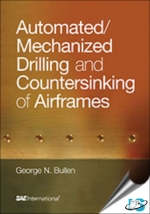Tab Article
Modern aircraft manufacturing involves drilling and countersinking hundreds of thousands to millions of holes. Doing this work by hand accounts for 65% of the cost of airframe assembly, 85% of the quality issues, and 80% of the lost time due to injuries.
Automated drilling and countersinking replaces traditional hand methods and involves using numeric control machinery to drill and countersink a finished hole “one shot” (drilling a finished hole without using pilot holes or tool changes). This is a proven cost reducing technology that improves quality where it has been applied successfully.
The focus of this book is on automating the process of drilling and countersinking holes during airframe manufacturing. Since this is the area of greatest return on investment for airframe producers, the book provides a stepped approach for evaluating possible areas for applying automation and a detailed description of the process for choosing, acquiring, and transitioning the right machinery for success. It also provides a vision for a 10- to 15-year future state of airframe manufacture.
Readers will use the information to:
- Understand the evolution of automated/mechanized drilling and countersinking airframes.
- Access decision models and matrices to help evaluate the feasibility of applying automation/mechanization to any airframe.
- Gain access to a step-by-step procedure to select the right piece of machinery.
- Learn the necessary processes for testing and transitioning machinery to production.
- Assess and acquire data to evaluate the effect of the process.
- Choose and train the right individuals to manage and run the machinery.
- Conduct cost benefit analysis models.
- Make recommendations for maintenance and spares.
- Address socio-economic factors to reconfigure a facility from hand to automated activities.
No other book provides such detailed technical, economic, and social information about automating the single largest contributor to airframe cost.


